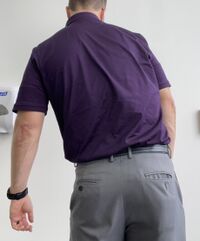Lumbar Lateral Shift
Original Editor - Matt Huey
Top Contributors - Matt Huey and Carina Therese Magtibay
Definition[edit | edit source]
A lateral shift is a pathology in which the superior spinal segment moves in the frontal plane causing the shoulders to go to one direction and the hips in the opposite. The exact cause is speculated but believed to be either caused by muscle spasms, the body avoiding irritation of a spinal nerve, or disc material displacement. There can also be cases in which internal implants have shifted causing a lateral shift. It is typically named for the direction that the shoulders are going ie, left lateral shift the shoulders are to the left, the hips are to the right.
A lateral shift is often seen with an acute onset of back pain with or without radicular symptoms. The shift can occur towards the side of pain (ipsilateral) or away from the side of pain (contralateral). It is most visible when the patient is standing and corrects in an unloaded position such as laying down.
Prevalence[edit | edit source]
There is not consensuses on the exact percentage of patients with back pain experienced but it has been stated to be between 5.6% to 80%[1][2][3]. It is believed that if someone presents with a lateral shift, the prognosis is poor with conservative care[4] . However, the prognosis improves if the shift is contralateral and the patient is able to correct the shift with a manual procedure[5].
Treatment[edit | edit source]
Mechanical Diagnosis and Therapy or the McKenzie Method is the most commonly used method in the treatment of a lateral shift[6][7]. Shifts can be corrected either by the patient, through repeated or sustained side glide movement, but in many cases the patient is unable to correct the shift themselves and requires a manual shift correction.
Manual Shift correction[edit | edit source]
This technique is most often needed due to the patient being unable to correct their shift by themselves. First the patient stands with their feet shoulder width apart and attempts to bear weight equally on both feet. The therapist stands to the side of the shift (left lateral shift means the shoulders are to the left and the hips to the right). The therapist has the patient bend their elbow and place the upper arm against their trunk. The therapist then places their shoulder against the patient's arm with their head behind the patient, and reaches around to place their hands on the opposite lateral hip. The patient is instructed to bring their hips toward the therapist while the therapist applies a force pull the hips to the opposite side and stabilizes the upper body. The patient goes as far as they can/tolerates, then backs off slightly (do not allow to return to the original starting position), then performs the maneuver again. Continue until the patient's hip are all the way to end range opposite the starting position. At this time the patient performs repeated standing extension. If the patient needs to rest, it is often preferred to have the patient rest in the prone position to avoid going back into the shift.
Self Shift correction[edit | edit source]
This is typically done if the patient is able to reduce and abolish their symptoms on their own or as maintenance after a manual shift correction. It is performed against a wall or door frame, a sturdy surface for the patient to brace against. The patient stands with their shoulder against the wall. The bend their elbow and place their upper arm against their side. They then need to have their feet approximately 12-18 inches away from the wall, this allows more motion of the hips to the wall. They then glide their hips toward the wall. The patient should not return to the original starting position but often to the neutral position.
If the patient needs more room due to wide hips or increased motion, a pillow or the like can be placed as a spacer between their upper body and the wall. The patient can also give themselves overpressure with their outer hand to push more into the range.
References[edit | edit source]
- ↑ Peterson, S., & Hodges, C. (2016). Lumbar lateral shift in a patient with interspinous device implantation: a case report. The Journal of manual & manipulative therapy, 24(4), 215–222. https://doi.org/10.1179/2042618615Y.0000000019
- ↑ Fritz, J. M., & George, S. (2000). The use of a classification approach to identify subgroups of patients with acute low back pain. Interrater reliability and short-term treatment outcomes. Spine, 25(1), 106–114. https://doi.org/10.1097/00007632-200001010-00018
- ↑ Kilpikoski, S., Airaksinen, O., Kankaanpää, M., Leminen, P., Videman, T., & Alen, M. (2002). Interexaminer reliability of low back pain assessment using the McKenzie method. Spine, 27(8), E207–E214. https://doi.org/10.1097/00007632-200204150-00016
- ↑ Porter, R. W., & Miller, C. G. (1986). Back pain and trunk list. Spine, 11(6), 596–600. https://doi.org/10.1097/00007632-198607000-00011
- ↑ May, S., & Donelson, R. (2008). Evidence-informed management of chronic low back pain with the McKenzie method. The spine journal : official journal of the North American Spine Society, 8(1), 134–141. https://doi.org/10.1016/j.spinee.2007.10.017
- ↑ Ross, J. (1998). Management of the lateral shift of the lumbar spine. Manual Therapy, 3, 62-66.
- ↑ Laslett M. (2009). Manual correction of an acute lumbar lateral shift: maintenance of correction and rehabilitation: a case report with video. The Journal of manual & manipulative therapy, 17(2), 78–85. https://doi.org/10.1179/106698109790824749









